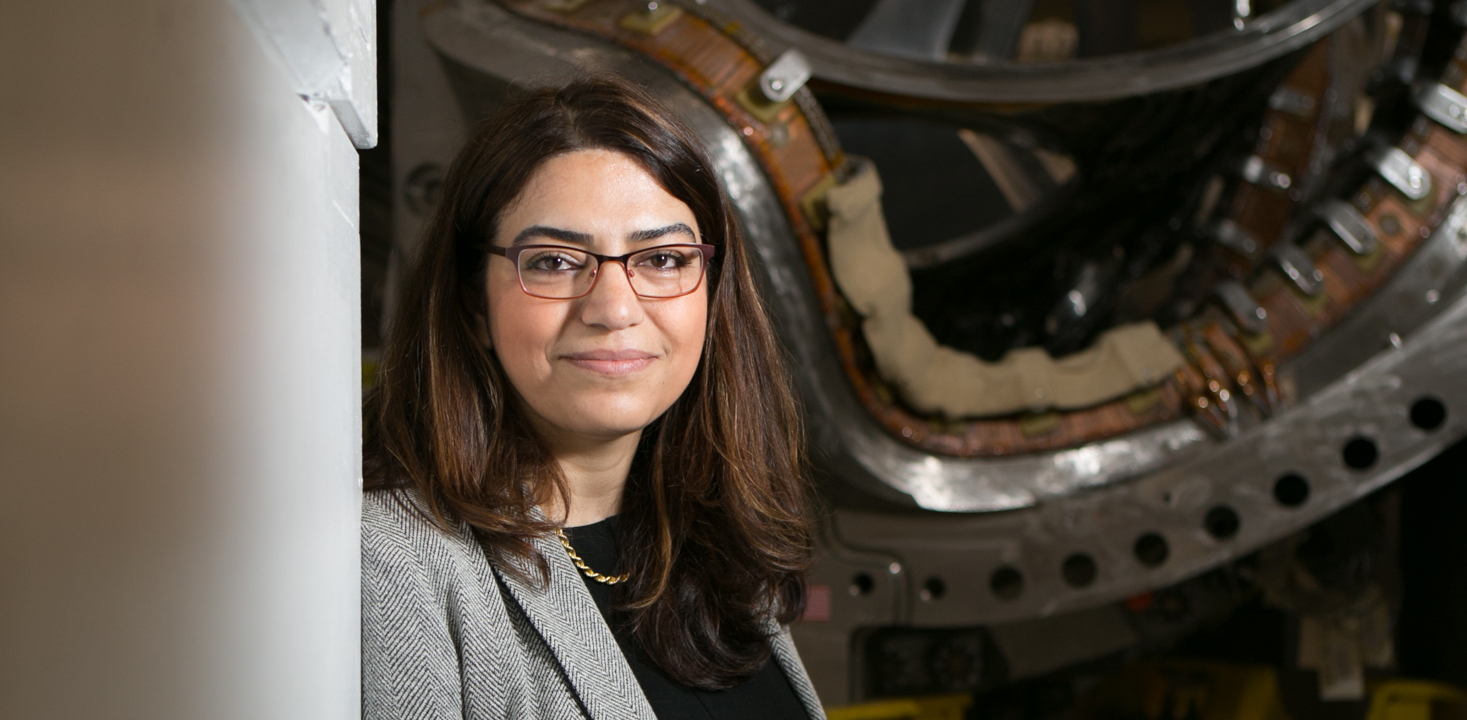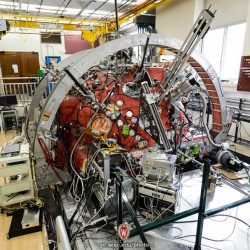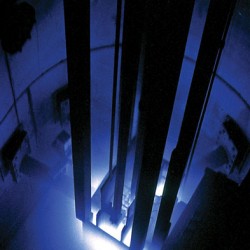
A Future for Nuclear Fusion
Physicist Fatima Ebrahimi PhD’03 pursues her passion with relentless energy.
Fatima Ebrahimi PhD’03 is determined to unravel one of today’s most pressing needs.
Ebrahimi is a principal research physicist in the Princeton Plasma Physics Laboratory’s Theory Department and an affiliated research scholar in Princeton University’s Department of Astrophysical Sciences. She strives to fully understand what many believe could be the answer to unlimited, clean, and reliable energy: nuclear fusion. She mirrors the very subject she studies, driven by seemingly limitless energy to help direct the future of the field.
Although nuclear fusion — a means by which the sun produces its own energy — has been achieved in laboratory settings, current strategies are neither efficient nor reliable for producing energy on a large scale. Researchers, including Ebrahimi, are working to better understand and control fusion on Earth to develop a sustainable method that produces more energy than it uses.
“It will be fantastic. The whole world will change,” Ebrahimi says of the day when this method becomes a reality.
In her pursuit to understand the mechanics of nuclear fusion, Ebrahimi stands out for her desire to discover why things work the way they do. In addition to collaborating with fellow physicists, she takes walks and pulls late nights to think through problems alone. In her day-to-day research, Ebrahimi also explores unconventional approaches to fusion and calculates the physics behind her computer simulations.
“[Ebrahimi] has very good physical insight into the physics problems, and she complements the computer calculations with … calculations on pencil and paper to try to benchmark and understand the output from the large computer codes,” says Stewart Prager, who was Ebrahimi’s doctoral adviser at the UW and is now a professor at Princeton. “This capability, plus her appreciation for experiments, I believe distinguishes her from many other computational physicists.”
As a part of understanding the physics she computes, Ebrahimi fuses her work in laboratory physics with astrophysics. In one of her recent studies, she examined the behaviors of plasma (a hot, ionized gas present in fusion) and how they may affect studies about both Earth and space.
For one of these behaviors — magnetic reconnection, a process believed to be related to solar flares — she found that it has the potential to degrade the performance of a fusion reactor. Gaining a foundational knowledge about this process helps solar physicists and astrophysicists understand the nature of solar flares; understanding flares has become important for researchers to further study how to control fusion.
Nuclear fusion is a process that releases energy when lightweight atomic nuclei — such as forms of the hydrogen atom — join. In some reactors, scientists apply extreme heat to these hydrogen atoms to form plasma. The plasma is then controlled using magnetic confinement, allowing for the fusion of atoms.
As opposed to some of today’s energy sources, fuels for fusion reactors could be extracted from water and would not emit carbon dioxide. Ebrahimi also says fusion would not produce radioactive waste, and that it would be reliable — unlike the unpredictability of weather-related factors needed to power solar panels and wind turbines. Together, these factors help make nuclear fusion a coveted candidate for a new energy source.
Ebrahimi grew up in Tehran, Iran, during the turbulent times of the Iran-Iraq War.
“I was able to continue my education. But it affects [you], you have these memories,” she says, noting that everyone living in Tehran faced scarcity of “almost everything” — from foreign goods to food. “I also have memories of being wakened by air-raid sirens and running for shelter, and sometimes temporarily [evacuating].”
In high school, Ebrahimi first discovered her curiosity about physics. She naturally excelled at it and found herself wanting to understand the physical laws that determine how matter and energy interact. She wondered if there was a unified law that could explain it all.
“I think that was the thing for me,” she says. “The universality was something I was looking for.”
She went on to earn her bachelor’s and master’s degrees in physics at the Polytechnic University of Tehran. During these years, she explored several areas of the subject — including plasma physics — and wanted to understand how they worked together to govern the universe. But she found herself gravitating more and more toward plasma physics. Although an area less focused on a universal law, it’s one in which several branches of physics overlap.
Ebrahimi then moved to Sweden to begin a doctoral program at the Royal Institute of Technology, where she started specializing in plasma physics and fusion. After a year, however, she decided she wanted to continue her research in the United States.
“Something was missing [in Sweden],” Ebrahimi recalls, adding that research there lacked a multidisciplinary approach. Researchers from the U.S. also had visited — including some from the UW, where a world-leading fusion experiment was located. “There was something special about the research environment in the U.S. It was clear from the scientists that I wanted to be there, and I wanted to work with them.”
Shortly after, Ebrahimi applied to a doctoral program at the UW. “I applied for other places, too, but I think I just felt that this was the right place for me to go to do my PhD,” she says.
At UW–Madison, Ebrahimi saw opportunities to learn within a plasma physics program that offered a wide breadth of fusion experiments located on campus — important features that were difficult to find elsewhere.
While completing her doctorate at the UW, she continued to study a fusion method she’d begun in Sweden. She worked with the Madison Symmetric Torus located in Chamberlin Hall, conducting simulations to understand how to efficiently sustain a steady, controlled plasma current for an extended period of time — something that physicists today are continuing to study, as it will be necessary to harness if we are to use fusion for energy.
Ebrahimi collaborated with others in the lab to put her computational results into practice, hoping to understand the physics behind these simulations. This effort to validate computational research against a laboratory experiment is important because it helps provide more confidence in the results, says Ellen Zweibel, a professor in the UW’s Departments of Astronomy and Physics.
Ebrahimi met Zweibel while conducting her postdoc studies and research at the UW. They worked together through the UW’s former Center for Magnetic Self-Organization (CMSO), which joined the studies of phenomena seen in both astrophysics and plasma physics.
Although mainly focused on laboratory plasma research, Ebrahimi gained exposure to astrophysics by working at CMSO and with her adviser Stewart Prager, Zweibel, and a mentor whom she’d met in Sweden, the late Dalton Schnack of the UW’s Department of Physics.
This cross-disciplinary approach taught her to think of problems differently, applying knowledge from her fusion research in the laboratory to astrophysics and vice versa.
“It is a strength of Fatima’s that she is able to … walk over and collaborate with experimenters and help them understand what they’re seeing in the experiment,” Prager says. “She also has had collaborations with astrophysicists who don’t study plasmas in the laboratory at all, and she’s able to bridge that gap and apply her work to both laboratory and astrophysics.”
Zweibel notes that she and Ebrahimi were the only senior women involved in CMSO while it was still on campus. Since that time, Zweibel has noticed that the number of women in astronomy remains consistently higher than the number of women in plasma physics.
Despite the numbers and her hopes for more women to follow, Ebrahimi focuses on what she can control — pursuing her passion to solve the puzzle of nuclear fusion.
“You find a problem that you’re excited about, and you work on it. That’s it,” she says.
“Women are underrepresented in the U.S. fusion community, especially in senior positions,” she adds. She also recalls an experience when, for nearly a year, she faced delays in obtaining a visa to return to the United States for her postdoc at the UW — all while she continued to pay rent for her Madison apartment until her UW colleagues helped store her belongings. “In my case, being an immigrant was even harder, and until I became a U.S. citizen, several times it stalled my career.”
At the Princeton Plasma Physics Laboratory, Ebrahimi works with the National Spherical Torus Experiment Upgrade (NSTX-U) — one of the most powerful experiments of its type.
Some of her research builds from where her doctoral work left off, but it focuses on a different innovative method. She models her research using the NSTX-U — which is more compact than conventional fusion devices used by some researchers — to understand how to efficiently create a lasting, steady plasma current.
“You want to think out of the box,” Ebrahimi says, and — by taking on compact, non-boxlike approaches (a torus, after all, is more of a doughnut shape) — she does just that. “I think that’s what fusion also needs.”
By studying innovative methods, such as using compact devices, she says researchers may be getting closer to finding a sustainable, controllable solution — the ticket to using fusion as an energy source.
Although researchers have made large strides in the past few decades, Ebrahimi says that it’s difficult to predict when we will use nuclear fusion as a source of energy.
“Fusion is hard,” she says. It takes a global team: a variety of fusion projects are happening around the world, all of which help physicists gain a more comprehensive understanding of fusion. This multitude of projects is expensive but necessary, Ebrahimi says. The payoff, though, is expected to be well worth it.
“It’s unlimited [energy] for mankind,” she says. “It’s not for one generation. It’s for many, many generations to come.”
Stephanie Awe ’15 is a staff writer for On Wisconsin.
Published in the Summer 2019 issue




Comments
No comments posted yet.